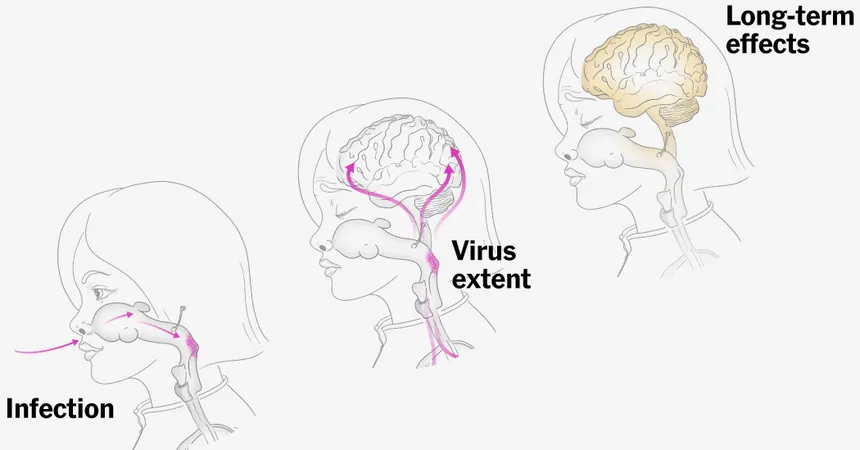
The Alarming Truth: How Measles Devastates Unvaccinated Children
2025-04-06
Author: Ling
For unvaccinated children, the threat of measles lurks everywhere—be it in classrooms, on school buses, or at grocery stores. This highly contagious virus has an unsettling statistic: nine out of ten unvaccinated individuals exposed to an infected person will contract it. Once inside the body, measles can wreak havoc on critical organs, including the lungs, kidneys, and brain.
Recent outbreaks in the United States have raised a significant alarm, leading to more than 580 reported cases and at least two tragic fatalities. As vaccination rates decline, health experts warn that we could see measles infecting hundreds, if not thousands, more children. Understanding the perilous journey of this virus through the body is crucial.
Unlike many other viruses, measles has a remarkable ability to linger airborne for up to two hours in previously occupied spaces. An unvaccinated child can inhale virus-laden droplets long after an infected peer has left a room where they played or studied. Upon entry through the nose or mouth, or even if the child rubs their eyes, the virus begins its insidious infection.
In a mere 24 hours, the virus settles into the nasopharynx, nestled in the cells at the back of the throat, and starts to spread to the lungs. It rapidly multiplies, creating countless copies in preparation for a widespread attack. Most concerning is that, during the initial replication phase, the child may not exhibit any symptoms. The incubation period can last from one to three weeks, at which point the infected child will begin to feel ill.
As the days roll by following exposure, telltale signs manifest—starting with malaise and fever, often accompanied by red, irritated eyes, a cough, and a congested nose due to inflamed mucus membranes. Notably, some children may develop distinct whitish-gray bumps inside their cheeks. Yet, these signs can sometimes go unnoticed.
The defining moment of measles is the outbreak of a characteristic red rash that begins on the face and subsequently spreads downwards. While many symptoms may resolve naturally—with the rash lingering for up to a week—prolonged fever following the rash can indicate dangerous complications. The persistent infection can lead to pneumonia or other organ-related issues.
Dr. Summer Davies from Covenant Children’s Hospital in Lubbock, Texas, has been on the front lines of treating measles cases since an outbreak began earlier this year. She describes alarmed families whose seemingly healthy children suddenly succumb to severe illness. The situations are dire, with many children requiring hospitalization due to compromised oxygen levels and respiratory distress.
The fever can soar to dangerous heights of 104 or 105 degrees, accompanied by dehydration from poor fluid intake, sore throats, and gastrointestinal distress. This combination can severely threaten kidney function, particularly in younger children who struggle to articulate their symptoms.
The stark reality is that about one in twenty children with measles may develop pneumonia, a condition that could be lethal. Dr. Davies highlights that many children recently admitted presented with pneumonia, often caused by either the measles virus or secondary infections that exploited their weakened immune systems.
In a heartbreaking case from Texas, a six-year-old girl died from measles complications, specifically pneumonia that led to fluid build-up in her lung, causing significant breathing difficulties. Her condition deteriorated rapidly, ultimately proving fatal after medical interventions failed.
Another alarming aspect of measles is the phenomenon referred to as "immune amnesia." This dangerous occurrence weakens the immune system's ability to protect against other infections, leaving these vulnerable children defenseless for months or even years.
About one in a thousand children who contract measles will also face the risk of encephalitis, a condition marked by inflammation of the brain, often resulting in irreversible damage. For infants or immunocompromised children, more severe conditions like measles inclusion body encephalitis (MIBE) can develop, leading to seizures and potentially coma.
Long after a seemingly resolved infection, children may suffer from subacute sclerosing panencephalitis (SSPE), a degenerative condition that can present years later, culminating in severe cognitive and motor decline, and a devastating mortality rate approaching 95%.
The tragedy endured by Erica Finkelstein-Parker, mother of Emmalee, who lost her eight-year-old daughter to SSPE, underscores the lasting consequences of measles. Unbeknownst to Erica, little Emmalee had contracted measles before her adoption from India, leading to a heartbreaking decline in her health.
To combat the resurgence of this once-eradicated virus, widespread vaccination remains the most effective defense. The message is clear: protecting our children from measles is not just a matter of health but a safeguard against potential lifelong consequences.


 Brasil (PT)
Brasil (PT)
 Canada (EN)
Canada (EN)
 Chile (ES)
Chile (ES)
 Česko (CS)
Česko (CS)
 대한민국 (KO)
대한민국 (KO)
 España (ES)
España (ES)
 France (FR)
France (FR)
 Hong Kong (EN)
Hong Kong (EN)
 Italia (IT)
Italia (IT)
 日本 (JA)
日本 (JA)
 Magyarország (HU)
Magyarország (HU)
 Norge (NO)
Norge (NO)
 Polska (PL)
Polska (PL)
 Schweiz (DE)
Schweiz (DE)
 Singapore (EN)
Singapore (EN)
 Sverige (SV)
Sverige (SV)
 Suomi (FI)
Suomi (FI)
 Türkiye (TR)
Türkiye (TR)
 الإمارات العربية المتحدة (AR)
الإمارات العربية المتحدة (AR)